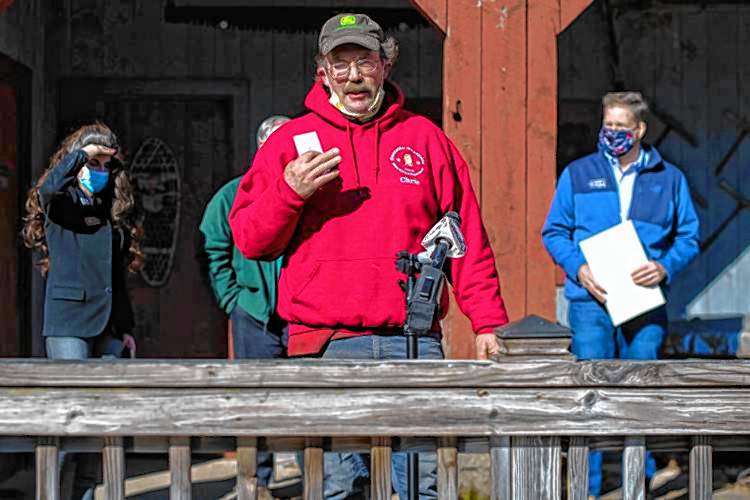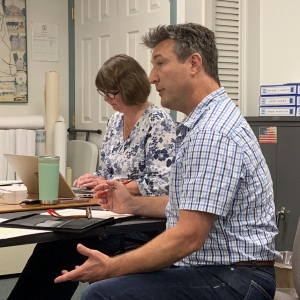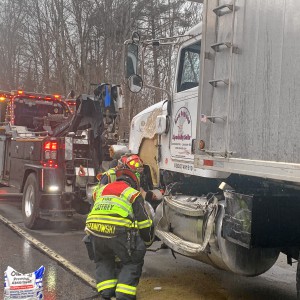Heavy rains hurt hay harvest

Chris Connolly addresses the crowd during Governor Chris Sununu’s visit to Connolly Brothers Dairy Farm in Temple to perform the ceremonial first maple tree tapping in 2021, Because of this year's rain, Connolly said he had to cut hay late, and it was “way past its prime.” —FILE PHOTO
| Published: 09-08-2023 8:36 AM |
For New Hampshire farmers who grow hay, the past couple of years have presented a bit of a Goldilocks situation. Last summer was too dry. This summer has been too wet. And that's a bad ending for this year's hay harvest.
“That's been the issue,” said Chris Connolly, a dairy farmer in Temple. “We go from drought conditions to monsoon season.”
Erratic weather has made agriculture in the state increasingly precarious this growing season, with extreme temperatures wiping out certain crops — like peaches and apples — in the spring and heavy rains drowning fields in the summer. For hay producers, the compounded effects of those weather swings have been particularly acute, with farmers seeing a lower-quality crop and a slim harvest.
Growing, harvesting and drying hay requires a balance of sunshine and moisture. Farmers usually cut the grass multiple times over the course of the growing season at different stages of the hay’s development cycle. Farmers have said this year’s wet weather has kept many fields too damp to properly harvest, and frequent rainy days have stymied the drying process.
“There’s a lot of fields that farms would have wanted to harvest, maybe around the first part of June, maybe early July at the latest, that have yet to be harvested,” said Carl Majewski, a food and agriculture field specialist with the University of New Hampshire Cooperative Extension.
Chris Gowdy, who grows hay for his cows in Walpole, has not been able to make an initial cut on over a third of his fields yet because they are too damp. He says the mud can damage equipment and create long-lingering ruts in the soil.
“We keep on getting these showers and it dumps an inch and a half, two inches of rain, and it's miserable to try and get any of the hay off the fields,” he said.
In addition to fields oversaturated from rain, about 12 acres of Gowdy’s farm were submerged under about five-and-a-half feet of water when the Cold River flooded in July, further reducing his crop yield.
Article continues after...
Yesterday's Most Read Articles
 ConVal officials propose one athletic director position
ConVal officials propose one athletic director position
 Sixteen-unit development draws ire from neighbors in Jaffrey
Sixteen-unit development draws ire from neighbors in Jaffrey
 UPDATE: Drivers identified in Jaffrey dump truck crash
UPDATE: Drivers identified in Jaffrey dump truck crash
 Mary Lawler remembered for a life of service
Mary Lawler remembered for a life of service
 Scott Bakula starring in Peterborough Players’ ‘Man of La Mancha’
Scott Bakula starring in Peterborough Players’ ‘Man of La Mancha’
 Spellers strut their stuff at inaugural Greenfield Spelling Bee
Spellers strut their stuff at inaugural Greenfield Spelling Bee
When hay is harvested too late, its quality and nutritional value drops dramatically. Once the rain receded slightly in August, Connolly in Temple was able to harvest and dry some of his crop, but he said cutting the grass so late meant it was “way past its prime.”
Hay is actually the largest crop by acreage in New Hampshire, covering around 42,000 acres of farmland, according to the UNH Extension. It plays a crucial role in the local food production system, feeding animals like cattle, sheep, goats and horses.
“All that local cheese and local milk and local ice cream comes from cows that are fed with local grass,” said Majewski.
Majewski said most farms that keep animals also cultivate hay to serve as a food source, which can be cheaper than purchasing feed. But this year, some farmers like Gowdy anticipate having to buy supplemental feed to get through the winter. Since wet weather affected producers across New England, he might have to order hay from more distant states, which will be more expensive.
Majewski said hay has long grown relatively easily in New Hampshire, but as the effects of climate intensify, its production is harder and less consistent. Scientists predict the state will be wetter and also more prone to extreme heat in coming decades, conditions that both make the haying process more challenging.
“Abnormal years are starting to become more normal,” he said.
These articles are being shared by partners in The Granite State News Collaborative. For more information visit collaborativenh.org.

 On the Trail: Democrat Maggie Goodlander jumps into race to succeed Kuster
On the Trail: Democrat Maggie Goodlander jumps into race to succeed Kuster ‘Dork Dancing’ coming to Depot Square in Peterborough
‘Dork Dancing’ coming to Depot Square in Peterborough Tour de Francestown has a new twist
Tour de Francestown has a new twist
